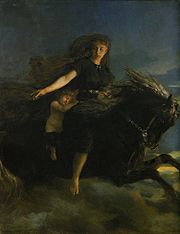
Skinfaxi and Hrímfaxi
Encyclopedia


Norse mythology
Norse mythology, a subset of Germanic mythology, is the overall term for the myths, legends and beliefs about supernatural beings of Norse pagans. It flourished prior to the Christianization of Scandinavia, during the Early Middle Ages, and passed into Nordic folklore, with some aspects surviving...
, Skinfaxi and Hrímfaxi are the horses of Dagr
Dagr
In Norse mythology, Dagr is day personified. This personification appears in the Poetic Edda, compiled in the 13th century from earlier traditional sources, and the Prose Edda, written in the 13th century by Snorri Sturluson...
(day) and Nótt
Nótt
In Norse mythology, Nótt is night personified. In both the Poetic Edda, compiled in the 13th century from earlier traditional sources, and the Prose Edda, written in the 13th century by Snorri Sturluson, Nótt is listed as the daughter of a figure by the name of Nörvi and is associated with the...
(night). The names Skinfaxi and Hrímfaxi are bahuvrihi
Bahuvrihi
A bahuvrihi compound is a type of compound that denotes a referent by specifying a certain characteristic or quality the referent possesses. A bahuvrihi is exocentric, so that the compound is not a hyponym of its head...
s, meaning "shining mane" and "rime mane" (or "frost mane"), respectively. Skinfaxi pulled Dagr's chariot across the sky every day and his mane lit up the sky and the earth below.
The myth of Skinfaxi is believed to originate in Nordic Bronze Age
Nordic Bronze Age
The Nordic Bronze Age is the name given by Oscar Montelius to a period and a Bronze Age culture in Scandinavian pre-history, c. 1700-500 BC, with sites that reached as far east as Estonia. Succeeding the Late Neolithic culture, its ethnic and linguistic affinities are unknown in the absence of...
religion, for which there is strong evidence of beliefs involving a horse pulling the sun across the sky. The Trundholm sun chariot
Trundholm sun chariot
The Trundholm sun chariot , is a late Nordic Bronze Age artifact discovered in Denmark. It is a representatino of the sun chariot, a bronze statue of a horse and a large bronze disk, which are placed on a device with spoked wheels....
is drawn by a single horse, and was possibly imagined to be pulled back across the sky west to east by a second horse. Related are Arvak and Alsvid
Arvak and Alsvid
In Norse mythology, Árvakr and Alsviðr are the horses which pull the sun, or Sol's chariot, across the sky each day.- References :...
, the horses of the chariot of Sól, now a team of two horses pulling a single chariot.
See also
- Shadowfax, a horse in J. R. R. TolkienJ. R. R. TolkienJohn Ronald Reuel Tolkien, CBE was an English writer, poet, philologist, and university professor, best known as the author of the classic high fantasy works The Hobbit, The Lord of the Rings, and The Silmarillion.Tolkien was Rawlinson and Bosworth Professor of Anglo-Saxon at Pembroke College,...
's Middle-earthMiddle-earthMiddle-earth is the fictional setting of the majority of author J. R. R. Tolkien's fantasy writings. The Hobbit and The Lord of the Rings take place entirely in Middle-earth, as does much of The Silmarillion and Unfinished Tales....

